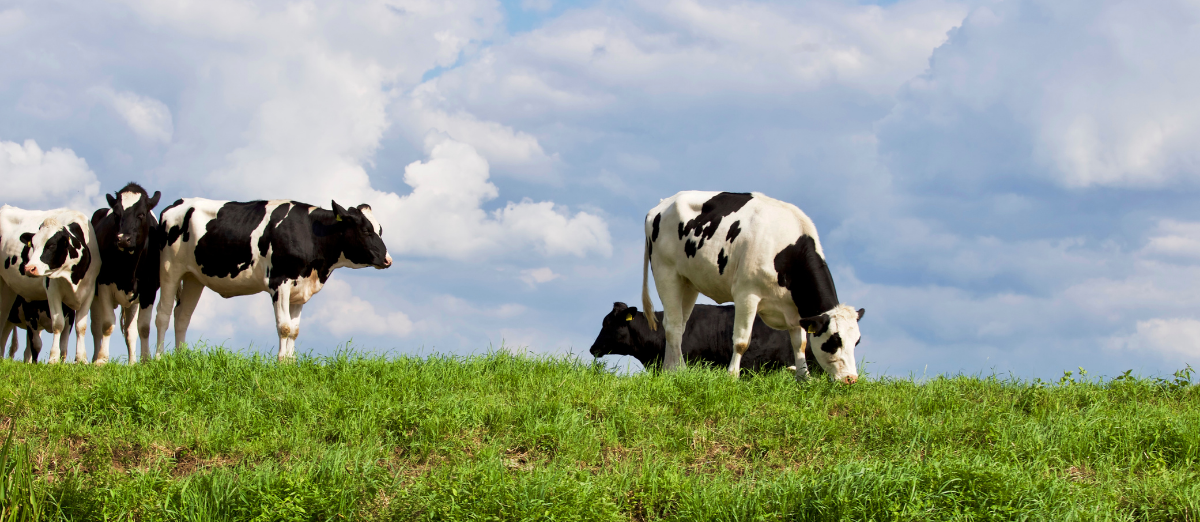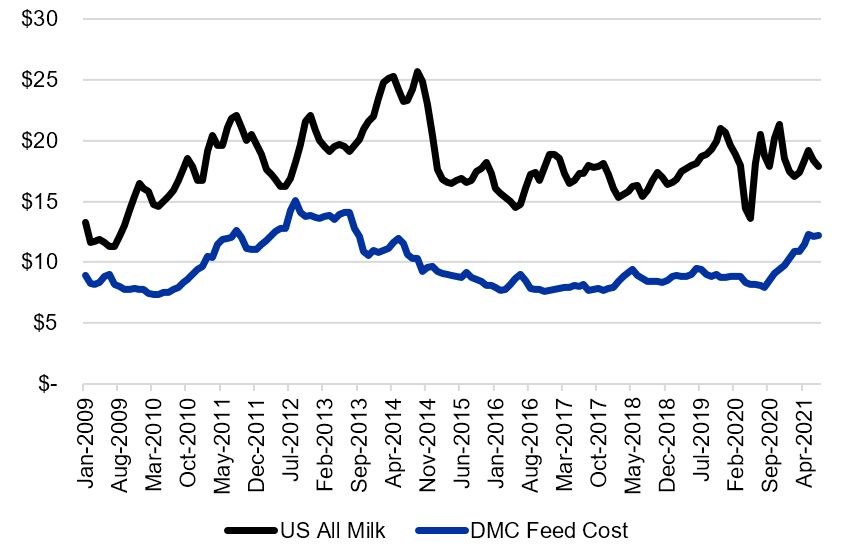Tools to Manage Risk for Dairy Producers
Tools to Manage Risk for Dairy Producers

Much discussion in the dairy sector last year was focused on the impacts of COVID-19 and the pricing issues that came with it. Mailbox prices in the Appalachian region, which includes Kentucky, typically exceed US All Milk price due to class I differentials and high class I utilization. However, the diversion between class III and class IV milk, combined with the new base class I skim milk pricing formula, left our regional prices below US All Milk in 2020, with considerable differences in several months. These producer price differentials (PPD’s) were the focus of an October 2020 Economic and Policy Update article by myself and David Anderson at Texas A&M University titled "Class I Pricing Continues to be a Major Challenge for Kentucky Dairy Producers".
While producer price differentials (PPD’s) have been less of an issue thus far in 2021, increasing feed prices are hammering dairy margins. This is probably best depicted by examining the figure below, which plots the US All Milk price and the Dairy Margin Coverage (DMC) feed cost from 2009. Note the blue line, which shows an increase in feed cost of $4.24 per cwt of milk produced from August 2020 to July 2021. While the DMC ration doesn’t perfectly represent feed costs on Kentucky dairy farms, it has become a recognized indicator of feed cost in the industry and does speak to the impact of rising feed costs on dairy profitability. Milk price volatility and rising feed costs continue to be risks that dairy producers are forced to manage.
Figure 1: US All Milk Price and DMC Feed Cost
(January 2009 to July 2021)

source: USDA-NASS and USDA-AMS
Fortunately, there are several tools available to dairy producers and I want to use the remainder of this article to review those. The first tool to consider is the DMC program itself, which has been around since the last farm bill. Through DMC, producers can receive compensation when the margin (US All Milk price minus DMC feed cost) drops below a specified level. For producers covering up to 5 million lbs of milk per year, the $9.50 coverage level is relatively inexpensive. Despite the fact that 2020 created unusual basis between Kentucky milk prices and the US All Milk price, the DMC program remains an attractive risk management tool. As an illustration, the average payment made per cwt of milk production for the first seven months of 2021 has been nearly $3 per cwt. While no program is perfect, DMC provides a relatively inexpensive opportunity to get some margin risk coverage for up to 5 million lbs of annual milk production. I generally tell producers that DMC is layer number one of their risk management plan and enrollment occurs through USDA Farm Service Agency offices.
Livestock Gross Margin for Dairy (LGM-Dairy) is a second risk management tool that very few producers have utilized. It is an insurance program that uses CME© futures prices for class III milk, corn, and soybean meal to estimate a margin above feed costs and producers can insure that margin with varying deductible levels. It is important to remember that LGM-Dairy margins cannot be compared directly to DMC margins with adjusting for differences in milk and feed prices and quantities. By insuring a margin, producer have some protection against decreasing milk prices and increasing feed costs. This same statement is also true to DMC, but a unique feature of LGM-Dairy is that producers can adjust the quantities of corn and soybean meal that are assumed per cwt of milk produced. While LGM-Dairy has not been heavily utilized in the South, it absolutely has some merit and is worth consideration.
A newer addition to the dairy risk management toolbox is Dairy Revenue Protection (Dairy-RP) insurance. Dairy-RP allows a dairy producer to insure a quarterly milk revenue based on CME© milk futures prices for that quarter and regional production level. While individual farm production levels are not utilized, regional production levels can be scaled upward or downward to more closely match farm productivity. Still, because production levels are based on the region, most of the risk reduction benefit is likely to be seen on the price side. Being insurance products, both LGM-Dairy and Dairy-RP are purchased through insurance agents.
Finally, producers should also remain aware that CME© futures and options are available for milk and some feeds. Since most Kentucky dairy operations are relatively small, contract size is often a challenge in utilizing futures as part of a risk management plan. CME© milk contracts are traded in each month and a class III or class IV milk futures contract is 200,000 lbs. Additionally, matching milk production quantities with feed quantities are even more difficult. However, larger dairy operations may be able to utilize futures and options directly.
The primary message is that there are risk management tools available that dairy producers need to consider utilizing as part of their marketing plans. They are all different and offer unique features, so understanding how they each operate is key to determining which programs meet the needs of an individual operation. The table below provides a quick comparison of the four tools discussed in this article based on some key features.
First, it is important to understand that the DMC program is the only tool that is not market-based. As markets evolve and price expectations change, the prices and margins that can be covered through LGM-Dairy, Dairy-RP, and CME© futures will also change. Those programs are in no way countercyclical. However, the margins that can be guaranteed through DMC are fixed regardless of market conditions. For this reason, at times dairy producers can enroll in DMC with an extremely high probability of payment.
Secondly, DMC-Dairy and LGM-Dairy both have feed cost / ration components that provide some protection against increasing feed costs. In the case of DMC-Dairy, these feed quantities are fixed, while corn and soybean meal quantities can be adjusted through the LGM-Dairy insurance product. In theory, quantities of feed can be adjusted through CME© futures and options contracts, but scaling these to match milk contract size becomes very difficult unless the dairy operation is extremely large.
Finally, Dairy-RP is the only tool that can potentially provide coverage for decreases in production. The fact that this is done is regional manner is significant and one must understand that individual farm production is not insured. Death loss, milk loss, or other production issues at the farm level are not covered in any way. Given the regional approach, Dairy-RP really only provides protection against production decreases that are incurred across the region. Extreme weather challenges are likely the best example as that would affect most all dairy operations and impact production at the regional level.
Table 1: Quick Comparison of Key Features for Dairy Risk Management Tools
| Market Based | Includes Feed Cost Element | Adjustable Feed Ration | Includes Production Element | |
|---|---|---|---|---|
| DMC-Dairy | X | |||
| LGM-Dairy | X | X | X | |
| Dairy-RP | X | X- | ||
| Futures/Options | X | X- | X- |
Recommended Citation Format:
Burdine, K. "Tools to Manage Risk for Dairy Producers." Economic and Policy Update (21):9, Department of Agricultural Economics, University of Kentucky, September 30th, 2021.
Author(s) Contact Information:
